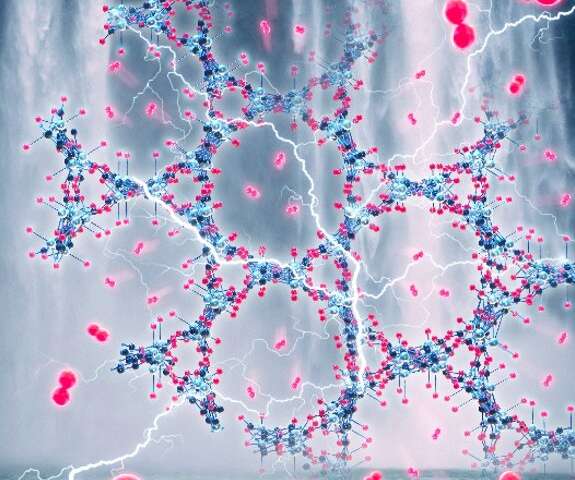November 30, 2020
feature
The oxygen evolution reaction (OER) is a chemical process that leads to the generation of molecular oxygen. This reaction is of key importance for the development of clean energy technologies, including water electrolyzers, regenerative fuel cells and rechargeable metal-air batteries.
The extent to which this reaction occurs has so far been limited in many materials, which has restricted the conversion efficiency of some types of energy technologies. Materials scientists have thus been trying to identify alternative materials, including metals, metal oxides and hydroxides, that could be used as electrocatalysts to fuel this reaction. The materials identified so far, however, are far from ideal for large-scale implementation, as they are either not particularly resistant or too expensive.
A class of materials widely investigated as possible electrocatalysts for the OER are metal-organic frameworks (MOFs), hybrid and crystalline compounds that consist of a regular array of positively charged metal ions surrounded by organic molecules. While these materials have promising catalytic properties, scientists have yet to identify optimal strategies to enhance their performance.
Researchers at the National Center for Nanoscience and Technology in China, the University of Sydney and the Chinese Academy of Sciences have recently devised a strategy that enables the structural transformation of highly active MOFs during the oxygen evolution reaction. This strategy, presented in a paper published in Nature Energy, could increase OER activity in emerging energy technologies, thus improving their conversion efficiencies.
“In 2016, we discovered a class of ultrathin metal-organic framework nanosheets (UMOFNs) that exhibited the superior activity and stability for electrocatalytic oxygen evolution,” Zhiyong Tang, one of the researchers who carried out the study, told Tech Xplore. “Once reported, it aroused broad interest in the scientific community and substantial improvements in the catalytic activity towards the water splitting have been successfully achieved using different MOF-based materials. Even if our MOFs design appears quite promising, the fundamental issue about the origin of high OER catalytic activity motivated us to embark on the five-year research exploration that culminated with our recent paper.”
The primary objective of the recent study carried out by Tang and his colleagues was to unveil the origin and causes of high OER activity during MOF electrocatalysis. Ultimately, this would allow the researchers to design highly performing OER electrocatalysts that can reduce the energy consumption and increase the efficiency of electrolyzers.
“We discovered a potential-induced two-step reconstruction at the metal anodes of MOFs,” Tang explained. “We found that metal species will convert to Ni0.5Co0.5(OH)2 and Ni0.5Co0.5OOH0.75 species at relatively low and high applied potentials, respectively. The in-situ formed Ni0.5Co0.5OOH0.75 (at high applied potential) with abundant oxygen vacancies and high oxidation state correlates well with high oxygen-evolving activity.”
The approach to structurally transform highly MOFs during the OER devised by Tang and his colleagues is simple and could eventually be used to produce clean energy technology at room temperature on a large scale. Using this approach, the researchers created OER catalysts that could be integrated into a variety of renewable energy technologies, including electrolyzers, metal-air batteries and reversible fuel cells, improving their conversion efficiencies.
“We discovered a structural transformation and identify the high active species during MOF electrocatalysis,” Tang said. “Our work introduces an atomic-level catalytic mechanism of MOFs catalysis, but also paves the way to design high-performance MOF-based OER catalysts. Using this mechanism, we developed a high-performance NiFe MOF catalyst with an extremely low overpotential and we are now seeking additional support to scale up this work for large-scale testing.”
More information:
Structural transformation of highly active metal-organic framework electrocatalysts during the oxygen evolution reaction. Nature Energy(2020). DOI: 10.1038/s41560-020-00709-1.
Ultrathin metal-organic framework nanosheets for electrocatalytic oxygen evolution. Nature Energy(2016). DOI: 10.1038/nenergy.2016.184.
2020 Science X Network
Citation:
A strategy to transform the structure of metal-organic framework electrocatalysts (2020, November 30)
retrieved 30 November 2020
from https://techxplore.com/news/2020-11-strategy-metal-organic-framework-electrocatalysts.html
This document is subject to copyright. Apart from any fair dealing for the purpose of private study or research, no
part may be reproduced without the written permission. The content is provided for information purposes only.



